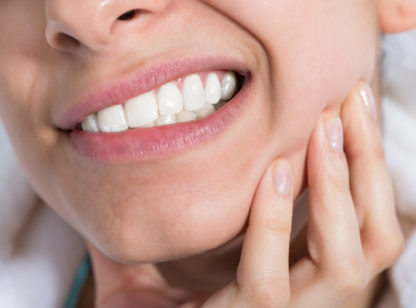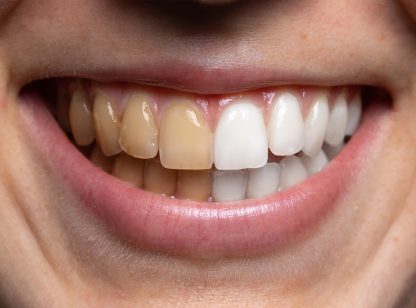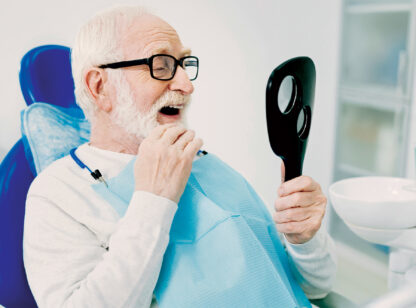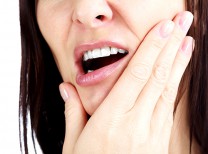Many people suffer for years from debilitating symptoms such as migraine-like headaches, blurred vision, dizziness, ringing in the ears, soreness around or pain behind the eyes, facial pain, or clicking of jaw joints. Their first course of action is to visit their primary care physician, who may treat the symptoms with no clear diagnosis for the cause.
Although TMJ (or Temporomandibular Joint Dysfunction) has been known for more than 50 years, only recently has data confirmed a definite connection between TMJ and other common head and upper body ailments. The fact that it mimics so many other diseases and conditions prompted one doctor to nickname it “The Great Imposter.”[sup]1[/sup]
TMJ dysfunction is a condition of “dislocated or crooked jaws.” Because of its effect on the many nerves that pass through the jaw joint to the rest of the body, symptoms can vary. The more bizarre and diverse the symptoms appear, the greater the likelihood it is TMJ at work.
Temporomandibular joint dysfunction is usually difficult to diagnose because it begins as a soft tissue injury. The longer the condition goes untreated, more symptoms occur and more parts of the body are affected. In fact, a patient may present the doctor with numerous symptoms that appear to have no relationship to the jaw joint itself.
Additionally, the symptoms are not always constant, especially in early stages. They can be sporadic – intense for years, then followed by a lapse, making the condition extremely elusive to diagnose. Consequently, many chronic suffers of TMJ are referred from doctor to doctor, in search of relief from recurrent and in some cases unbearable and debilitating pain. The intensity and duration of this pain can lead to emotional problems for patients trying to cope.
According to Dr. Brendan Stack, director of the Nation Capital Center for Craniofacial Pain in Falls Church, Virginia, many persons with TMJ syndrome who go through a litany of tests with negative results end up on a psychiatrist’s couch after being told by doctors their pain is “all in their head.”[sup]2[/sup]
What causes TMJ?
The temporomandibular joint is the hinge of the side of the face that connects the jaw, or mandible, to the temporal bone of the skull. It is located just in front of the ear and is responsible for all jaw movements. If this joint is out of place because of teeth grinding, a blow to the jaw, whiplash injury, birth defects or opening the jaws too wide, the joint can be displaced. This places pressure on nerves that pass through the joint causing a variety of pain and very bizarre symptoms.
According to Dr. Harold Gelb, director of the Temporomandibular Clinic at the New York Eye Infirmary, the problem is actually an orthopedic one. “If one foot is shorter than the other, the entire body is unbalanced. The jaws work the same way. When the teeth don’t meet properly, the jaws become tense and strained, and stress is put on the joints. Because the head, jaw, neck and shoulder muscles are all interrelated, when there’s an imbalance, they are all affected.”[sup]3[/sup]
Dr. Gelb speculated that about 90% of all headaches are due to muscle spasms or contractions, and that muscle contractions in the jaw joint are a potential cause for headaches in as many as 40 million of the country’s chronic pain suffers.
Taking the Mystery Out of Diagnosis
Beyond the need for a physician or dentist who has knowledge of this condition, the greatest help in detecting TMJ is a specialized x-ray machine called a cephalometric tomography. This X-ray creates 3-D imaging in layers allowing doctors to examine various levels of the joint for evidence of jaw displacement or other pathological changes.
This equipment is imperative to diagnosis and determination of the degree of injury considering that normal x-ray equipment usually cannot capture this jaw dysfunction.[sup]4[/sup]
Dr. Nikolaas Tinbergen was able to demonstrate that changes or problems in body structure can affect the health of the entire body. For this discovery, he won the Nobel Prize for Medicine in 1973, a fact neither well-known nor publicized among physicians.
Later, Dr. Aelred Fonder, a dentist associated with the Dental Research Foundation in Illinois, demonstrated a list of systemic health symptoms (symptoms relating to particular organs or with the whole body) that abated when the temporomandibular joint was corrected. In observing women with such conditions as migraine headaches (99%); chronic sinusitis (86%); symptomatology of the eye (84%); and chronic skin rash (93%) co-existing with dental stress conditions, Dr. Fonder found that “once the malocclusion or imbalance was corrected and the dental stress of temporomandibular joint malfunction and neuro-muscular imbalance was eliminated, patients’ symptoms diminished.”
When a person’s TMJ dysfunction has been corrected and that person is free of pain, not only does one feel better physically, but an overall sense of well-being can return.[sup]5[/sup]
Dr. Leonard Feld is a TMJ-TMJD Dentist with offices in Los Angeles, San Jose and Palm Desert. He is the co-founder of the TMJ & Sleep Medicine Network and his philosophy is always conservative, non-invasive and non-surgical treatment. Dr. Feld can be reached at (760) 341-2873. www.DocFeld.com
References: (1) Feld L. “The Great Imposter” The Pain Practitioner Vol 2, number 2 pg. 44-55 Aug. 2010; (2) Stack B. Prisoners of Pain, Westways 1980; (3) Gelb H. The Temporomandibular Syndrome Ch.7 Clinical of Head and Neck pain and TMJ dysfunction W.B Saunders & Co.; (4) Isberg A. Temporomandibular Joint Dysfunction, A Practitioners Guide, London, Ontario. Martin Dunitz Pub; 2002; (5) Fonder A. The Dental Physician; Medical Dental Arts 1977, 1980, 1985.













































Comments (9)
True that. If only they were solutions for poor people. I feel like I’m dying. :(
My whole skeletal system and joints and walking have been affected by tmj but think the tmj was caused by a combination of a missing tooth and chest muscle wastage from a fall on ribcage Im in a living hell no one can seem to help me as they are treating all the symptoms separately even the occlusion specialist I am near the end of my tolerance levels my life mobility and career at 40 is ruined. Is there anyone out there who can help me
You should try looking into starecta. It’s easy to find using google. They send you a kit in the mail that includes everything you need to make an old of your teeth. After you make the mold you send it back to them and they make a splint or rectifier. It look like a set of clear retainers that you put over your teeth, and it shifts your jaw ever so slightly in the direction it needs to go. They work similarly to braces, but it is not painful from what I’ve learned about them. You will have to repeat the molding process every two weeks because you will need a new set of rectifiers to keep the process moving along. It’s a slow and steady process because your muscles and jaw joints have to adjust, which takes a lot of time. I’ve only read about them and I am hoping to get them one day myself, but I thought that I’d let you know about an alternative option that’s a lot less expensive and time consuming than what you might be going through. Hope this helps, and I hope you get the help you need.
I have all the classic symptoms and after several calls (two different specialist) have not been able to book an appointment, much less begin to receive the care I need.
I have this, but I cannot afford to treat it or get surgery, (in Canada). It’s terrible.
Symptoms started as tingling in hands. Since a year ago. November my jaw finally gave way and locked up. Saw a neuromuscular dentist by accident and got fitted with an orthotic to stabilize my bite. I get it adjusted once sometimes every 2 weeks. The pain is excruciating with full body pain and headaches and facial pain. The pain I don’t understand feels like a stitch in my sides. I feel as.if my stomach is tightening up and its horrible. My life has been stopped in its tracks. If anyone has this pain in the sides I would like to know cuz I don’t know if TMJ is causing it. Doing physiotherapy also. I feel like I want to just end it all in constant pain.
Thank you for reading, Maya. I wish we had answers for you, but I don’t know if the pain is related. As per the article, symptoms that seem unrelated can certainly be.
Brendan Stack is a leader in the field, but I would find someone in your area you feel comfortable with: http://sleepandtmjtherapy.com/our-team/
All the best to you ~
Lauren
I am having the pain in the sides of my chest to in the abdomen area I’m also having trouble thinking to and I’m forgetting things easily
Good Day, Jack ~
Thank you for reading Desert Health! These could be symptoms of many things and you certainly should go see your doctor – especially since your pain is in your chest area.
Lauren Del Sarto
Publisher